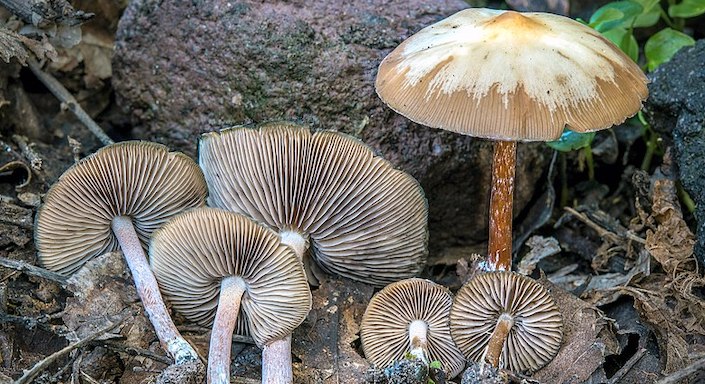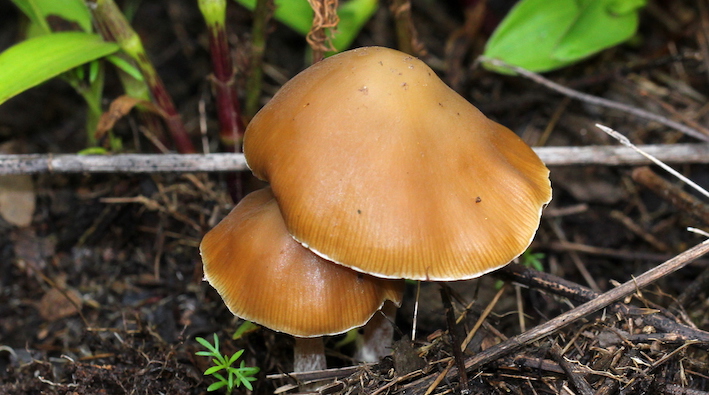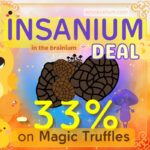He reported his experience in his now iconic article (published in LIFE magazine in 1957 and credited with bringing knowledge of magic mushrooms to the West) titled ‘Seeking The Magic Mushroom’. However, as mentioned above, these mushrooms have a facinating and ancient history that was established millennia before their introduction to the world stage.
So, let’s check them out!

A Good ‘Starter’ Shroom
As part of the Psilocybe genus, this shroom of course contains both psilocybin and psilocin as its predominant psychoactive compounds. However, it is not known for being especially strong, with a low to medium potency, and often a slightly shorter trip than is traditional — around 3-6 hours on average. For this reason, they are a good ‘starter’ magic mushroom, though, for foragers who come to Mexico hoping to trip out on the stronger P. mexicana they are said to be slight anti-climax. However, Paul Stamets still describes this shroom as ‘potent’.

Landslide Loving Shroom With Many Names
Known more commonly as ‘Derrumbes’ or ‘Landslide Mushroom’ — it is also included in the revered bracket of mushrooms (including Psilocybe mexicana) named ‘teonanacatl’ or ‘God Mushrooms’, by the shamans of both ancient and modern Mexico. It is hardy and easy-growing mushroom in the wild, favouring sites where the ground has been disturbed and other plants and fungus seldom grow. This, of course, includes areas which have had recent landslides (hence the name) — appropriately, ‘derrumbe’ means ‘collapse’ in Spanish.
Where and When?
This destruction-loving mushroom, P. caerulescens, is native to Mexico but has been cultivated for centuries outside of it. Hence, it can also be found in Brazil and Venezuela, as well as certain areas of the United States such as Florida, Georgia or South Carolina. However, they were first ‘officially’ identified in 1923, growing on sugar cane mulch in Alabama. It can often be found at higher altitudes, mountainous areas with some sunshine. It grows during the Mexican rainy season of June to October.

Look-Alikes
The P.caerulescens has a silver-blue shimmering lustre that makes it less likely to be confused with other shrooms. However, it can grow to a vast range of sizes, making it slightly less easy to identify with total certainty in the wild. If you can get your hands on some spores however, it is pretty easy to cultivate at home.
Vital stats: How to Spot This Shroom!
To identify a Psilocybe caerulescens , check out the following:
Cap: ranging from 3-7cm in diameter. Convex shape, rarely totally flattening out. Great variations possible in colour depending on moisture levels. When hydrated it can be yellow-brown to red-brown with its characteristic metallic silvery-blue sheen. When dry it can be beige to yellowish. Sticky when moist, with its edges becoming slightly translucent.

Gills: close to subclose. Whitish-grey in immaturity, maturing to purple-brown with edges remaining white-ish.
Spores: Violet brown in colour, hexagonal from the front view and oval from the side.
Stem (or stype): 5-9cm long and ranging between 8-10mm thick, widening slightly at the base. Whitish to ginger-brown, bruising blue-purple when damaged. The stipe can feature rhizomorphs (or tendrilly threads of mycelium) at the base.
Taste and Smell: The taste and smell of the Psilocybe caerulescens is described as farinaceous which means ‘containing starch’. Apparently similar to freshly ground flour. It is also described as having a strong hint of cucumber in its aroma too!
Can I eat it? : It is edible, but hallucinogenic. Proceed with caution
Find it: disturbed ground due to landslides, higher altitudes, sugar cane mulch.
When: In its native Mexico from June till October.
Family: Hymenogastraceae
Genus: Psilocybe
Species: caerulescens

 INSANIUM Deal
INSANIUM Deal 

 Combo deals >
Combo deals > . It only took 7 days from Australia which is really impressive. I am deeply grateful and excited to experience my truffles now. Looking forward to my journey within xxx
. It only took 7 days from Australia which is really impressive. I am deeply grateful and excited to experience my truffles now. Looking forward to my journey within xxx
 Strength up to 110/100
Strength up to 110/100 
 %
%
 500 gr.
500 gr. 
